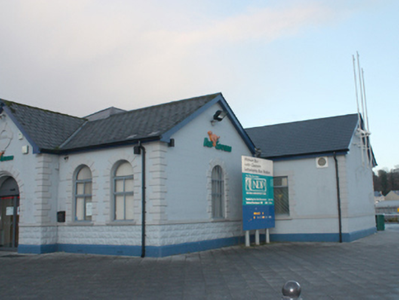Survey Data
Reg No
40502131
Rating
Regional
Categories of Special Interest
Architectural, Historical, Social
Original Use
Railway station
In Use As
Bus station
Date
1900 - 1910
Coordinates
217440, 411826
Date Recorded
01/12/2008
Date Updated
--/--/--
Description
Detached five-bay single-storey former railway station, dated 1908, having central gable-fronted single-bay projection to the front of the main elevation (west). Now in use as bus station (since 1987) with single-storey extension to rear (east). Pitched artificial slate roof with replacement rainwater goods. Painted smooth rendered ruled-and-lined walls over projecting chamfered smooth rendered plinth course with three courses of squared rock-faced walling rising to window sill level, smooth rendered sill course, and with smooth rendered block-and-start quoins to the corners. Date plaque to projecting entrance with date ‘1908’ surrounded by raised rendered block-and-start surround on (circular-plan). Round-headed window openings with painted limestone sills, smooth render block-and-start surrounds, with replacement windows. Square-headed window opening to rear with two-over-two pane timber sliding sash window and limestone sill. Round-headed door opening to projecting bay to front elevation (west) having raised smooth rendered block-and-start surround, modern glazed double-doors, and infilled overlight. Metal roof structure to interior having wrought-iron or steel trusses and roof structure supported on cast-iron columns with decorative cast-iron spandrels. Set back from road in own grounds to the north-east of the centre of Letterkenny with tarmacadam car and bus parks to site. Cast-iron winch\crane (see 40502318), originally associated with railway, located adjacent to the north-west. Altered detached five-bay single-storey former railway goods shed to the north-west, built c. 1913 and altered c. 2000 and now in use as offices, having modern glazed clerestory level with pitched slate roof over, rubble stone walls with concrete block-and-start quoins to the corners, and round-headed window openings with rendered block-and-start surrounds and modern fittings.
Appraisal
This former railway station, of early twentieth-century date, has successfully been adapted for use as a bus station. Although altered with the loss of original fabric to the openings and the construction of a modern block to the rear, it retains much of its original form and character. The variety of material to the original block with rock-faced masonry, ruled-and-lined walls over, and block-and-start quoins to the corners and surrounds to the openings, creates an interesting composition with a variety of textures and forms. Of particular interest is the survival of the original metal roof structure, although probably rebuilt, with attractive cast iron columns with decorative cast-iron spandrels supporting steel or wrought-iron roof structure. Foundry marks indicate that the cast-iron elements were made in Glasgow. This station opened in January 1909 following the construction of the Strabane to Letterkenny Railway by the County Donegal Railways Joint Committee. The station was built adjacent to an existing station that was originally built in 1883 by the Londonderry and Lough Swilly Railway Company as the terminus of the Burt Junction to Letterkenny section of the Londonderry to Letterkenny railway line. This appears to have been operated by a separate company known as the Letterkenny Railway Company. An additional line was built from this earlier station, later demolished, to Burtonport in 1903. There were formerly railway sidings connecting all these lines to this former station in Letterkenny. This station was in use from 1909 until the 1st of January 1960 when the railway line to Strabane was closed; the earlier railway lines ceased to operate in 1953. This building is an interesting historical reminder of the formerly extensive railway network in Donegal, and is an interesting element of the social history of the local area as a result. It now operates as a bus terminus continuing its original junction as a transport hub. It forms a group of related structures with the railway winch or crane (see 40502318) and the now altered former railway goods shed to the north-west.









